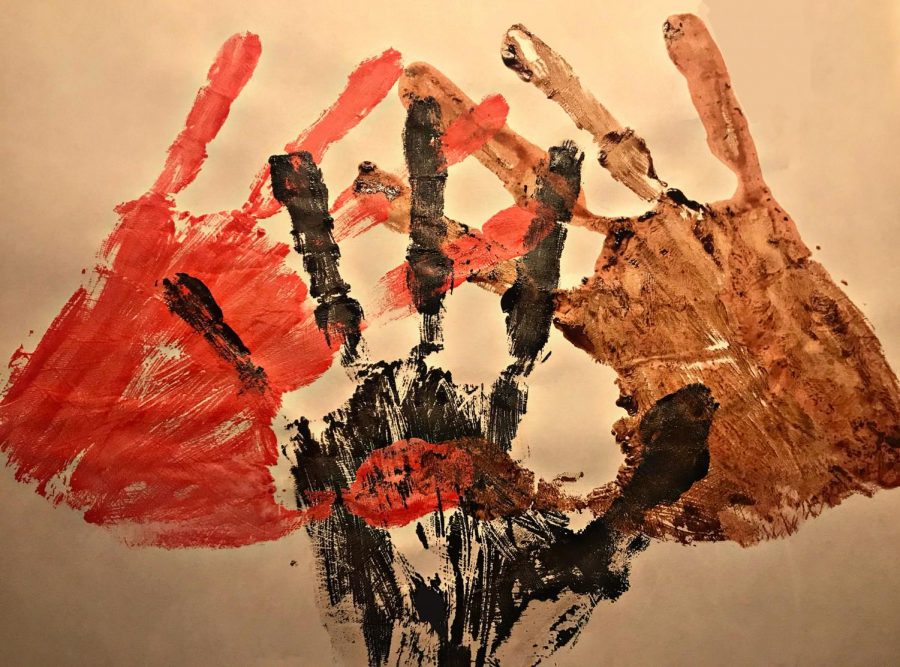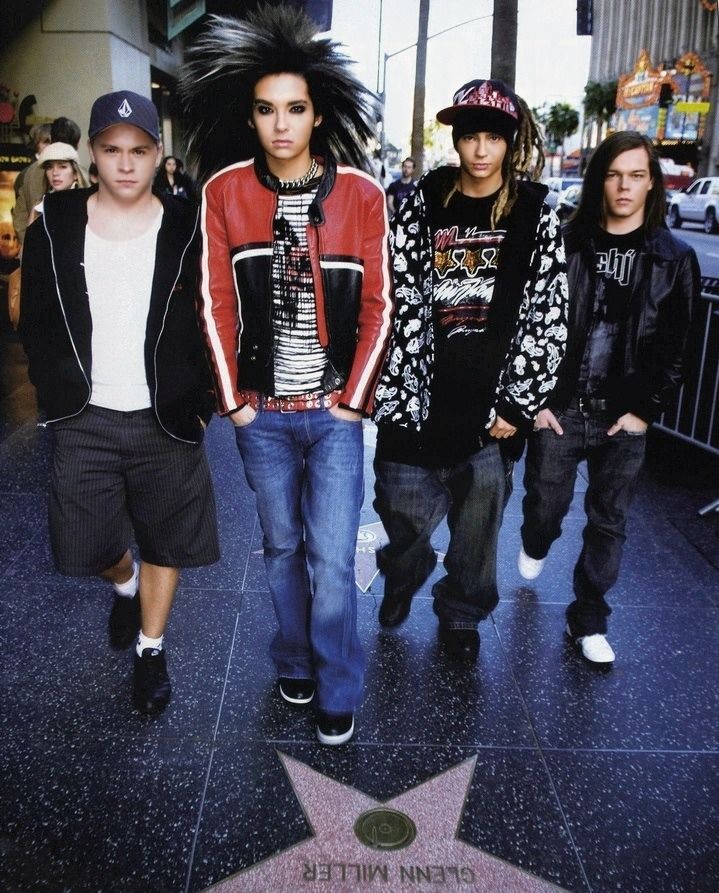Cultural Appropriation v. Appreciation
To represent the cultures that are talked about in this series, senior, Mariam Alashmawi painted hand-prints. Red representing Indigenous people, black representing African American people, and brown representing the Latino and Hispanic people.
There are so many cultures from different ethnicities, regions, and religions. Culture is defined as habits, beliefs, and traditions that a specific group of people practice. In the United States, many people share their customs with others to spread a piece of their culture. However, some people don’t take into consideration the meaning behind their customs and take it as a piece of fashion, a trend, or a costume. Since it’s almost spooky season, this is the perfect time to establish the difference between taking someone’s culture and respecting and appreciating their culture.
Many immigrants, people of color, and indigenous people in America people have been discriminated against for their culture. Now people are taking what they held proudly and are using it as a way to mimic the original, also known as, cultural appropriation.
In America, indigenous people were forced to change completely in order to fit the American ideal. In the 1880s, a common phrase used was “Kill the Indian in him, and save the man.” Americans during the 1800s believed that Native people were “savages” (this was and still is a racial slur used to demean indigenous people and make them feel inferior to the white man). Most indigenous people had to go through cultural assimilation, stripping them from their native language and religion. They had to change their native names, cut their long hair, and dress like the other white American people. Now in today’s society, people of non-native blood are “dressing” like indigenous people by using their war bonnets as an accessory, wearing indigenous symbols or patterns on their clothing, and drawing on themselves to resemble their idea of “tribal tattoos.” War bonnets were worn mainly by men who were either chiefs or warriors in some native groups symbolizing their bravery and battle accomplishments. Their tattoos and symbols held spiritual meaning and by drawing these “tattoos” or getting a tattoo of a dream-catcher, you are not acknowledging their roots. One of the biggest human genocides causing only 2% (5.4 million) of indigenous people to remain in America and now people of non-native blood want to bring back their culture like it’s some type of trend. That is disgraceful.
How is it okay to disrespect the people that created the idea and then praise the people who stole the idea?
— Mariam Alashmawi
African Americans have faced one of the worst cases of discrimination and racism in America. The U.S. has come a long way since discriminatory laws, such as the Black Codes and the Jim Crows Laws. However, that doesn’t excuse the fact men and women of color are still being treated unjustly and unequal. African American ancestors had their rights stripped away for 400 years, they were dehumanized with racial slurs, they weren’t allowed to learn how to read or write, and they weren’t allowed to practice any of their African culture. They were socially and economically controlled by the white man. Now in the U.S, African Americans have created their own culture which has made a huge impact on the language, dance, music, and fashion industry. Some of these ideas include streetwear, braids, edges, many different genres of music like jazz and hip hop -just to name a couple-, and so much more. However, many African Americans are still being discriminated against in jobs and schools for their culture. DeAndre Arnold was suspended from his school and wasn’t allowed to attend his high school graduation because his dreads were a violation of the school dress code. The school continuously tried to make him cut his hair in order to let him come back to school, however, DeAndre stood up for what believed to be a personal attack against his Trinidadian culture. In his interview with Ellen DeGeneres, he stated that there are many girls at his school who had long hair so he should have the right to keep his hair long. The school’s way of dealing with this racially insensitive and unacceptable. However, when a celebrity or a person that isn’t from African descent does it, it is considered “iconic” and the “new face of fashion.” Let us take for example actress, Bo Derek, wearing cornrows in the movie 10. This movie was filmed in the ’70s and some historical context that should be considered is that black men and women during this time couldn’t wear the natural hair or braid their hair in a workplace without being criticized and them being considered “distracting” and “unprofessional.” During the time 10 came out, many people started to use this hairstyle without knowing where it originated from and its historical context; it was just considered “cool” and “edgy.” How is it okay to disrespect the people that created the idea and then praise the people who stole the idea?
People think it’s funny to imitate the way a person talks and how they act, but they aren’t willing to understand the struggles they go through.
— Mariam Alashmawi
The Latino and Hispanic community has gone through a rough patch in America today. With the president making racist claims on these two groups as a whole, it is extremely difficult for people to see how great they are as people when we have someone preaching insanely false accusations on them. Latinos and Hispanic people have made a positive influence on the social, cultural, political, and economic life of the U.S. However, many people don’t give them the credit they deserve and still continue to get a bad rap. For example, in Mexican culture, they celebrate Dia de Los Muertos (Day of the Dead) to honor the lives of the loved ones who have passed in a respectful manner. Many people consider Dia de Los Muertos to be similar to Halloween. However, some people during Halloween want to mimic the Mexican holiday by doing the same face makeup as them and dressing up as them. This is disrespectful because, during the Day of the Dead, people consider it a celebration and a tradition to dress up and style themselves as skeletons of their deceased relatives to honor them. Another style that is worn during Halloween by non-Latino and non-Hispanic people, is the “cholo/Chola style.” Cholo/Chola means a young person who participates in or identifies with the Mexican American gang subculture. People think it’s funny to imitate the way a person talks and how they act, but they aren’t willing to understand the struggles they go through. People will draw a teardrop under there eyes, but they don’t realize what that symbolizes in the Cholo/Chola community. It isn’t okay to act like somebody who is or was in a gang. Gang and prison culture isn’t a culture you should be mocking; it is very disrespectful and inappropriate because you haven’t felt the same pain they have felt.
Some people say that they were “honoring” the culture and didn’t mean for it to be offensive, however, it is offensive. You cannot say you are honoring a culture when you dress up like them for one day. Honoring a culture is doing research on the culture, understanding the culture, learning their language and engaging with the community, discussing issues that are going on in their community, supporting culturally small businesses, and engaging with the culture instead of picking one thing you find aesthetically pleasing to the eye. Honoring a culture is about learning the history of the people and helping their culture grow in a positive way.
In conclusion, cultural appropriation tends to be confused with cultural appreciation, however, appropriation is taking a piece of somebody’s culture without acknowledging the historical context to fit your personal style, and appreciation is empowering a person with that culture and listening to their history without having to dress like them. If you do not practice the culture and you don’t know a lot about the culture, do not dress like them! because they don’t want you representing them. They want THEIR people representing them. If you’d like to dress like any culture, please dress like your own culture.

Mariam Alashmawi is a senior and this is her second year as a staff writer for the Silver Streak.













